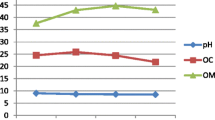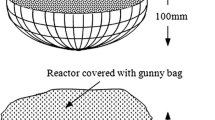Abstract
Parthenium hysterophorus is considered one of the most noxious terrestrial weeds which needs to be efficiently managed to sustain the environment and vermicomposting are a promising eco-friendly management technique. In the current study, vermicomposting of P. hysterophorus was carried out using a polyculture of two epigeic earthworm species, i.e., Eisenia fetida and Eudrilus eugeniae employed in five different vermireactors referred as Rp1, Rp2, Rp3, Rp4, and Rp5 with five mixing ratios 3:7, 4:6, 5:5, 6:4, and 7:3 respectively of P. hysterophorus to cow dung as a blending material. The nutrients in the final vermicompost were determined by analyzing different physico-chemical parameters and the efficiency evaluated by the growth rate of earthworms. After vermicomposting, TKN, TP, and K contents increased with the highest percentage change of 74.74%, 91%, and 47.2% respectively, compared to initial values. Reduction in C/N ratio was observed in all the vermireactors with the lowest C/N ratio of 9.76. EC increased for all the vermireactors during the process and reached in the range of 3.7–3.85 ds/m at the end of the process. The highest percentage gain in biomass of earthworms was 46.25% in Rp2. Vermicomposting of P. hysterophorus is possible for the management of this invasive weed through polyculture of the earthworms E. fetida and E. eugeniae to obtain a value-added organic fertilizer, i.e., vermicompost by a sustainable process.
Similar content being viewed by others
References
APHA (2012) Standard methods for examination of water and wastewater. American Public Health Association WWA, Washington
Adkins S, Shabbir A (2014) Biology, ecology and management of the invasive parthenium weed (Parthenium hysterophorus L.). Wiley Online Library. https://doi.org/10.1002/ps.3708
Ananthavalli R, Ramadas V, Paul JA, Selvi BK, Karmegam N (2019) Vermistabilization of seaweeds using an indigenous earthworm species, Perionyx excavatus (Perrier). Ecol Eng 130:23–31
Biruntha M, Karmegam N, Archana J, Selvi BK, Paul JAJ, Balamuralikrishnan B, Chang SW, Ravindran B (2020) Vermiconversion of biowastes with low-to-high C/N ratio into value added vermicompost. Bioresour Technol 297:122398. https://doi.org/10.1016/j.biortech.2019.122398
Blakemore RJ (2015) Eco-taxonomic profile of an iconic vermicomposter-the ‘African Nightcrawler’ earthworm, Eudrilus eugeniae (Kingberg, 1867). Afr Invertebr 56(3):527–548
Briones MJI, Garnett MH, Piearce TG (2005) Earthworm ecological groupings based on 14C analysis. Soil Biol Biochem 37:2145–2149
Butt KR (1998) Interaction between selected earthworm species: a preliminary, laboratory-based study. Appl Soil Ecol 9:75–79
Colema DC, Crossley DA, Hendrix, PF (2004) Fundamentals of soil ecology. Academic Press. https://doi.org/10.1016/B978-0-12-179726-3.X5000-X
CPHEEO (2000) Manual on municipal solid waste management, first edn. Cental Public Health and Environmental engineering Organisation, New Delhi
Darwin C (1859) On the origin of species. John Murray Publication
Fayolle L, Michaud H, Cluzeau D, Stawiecki J (1997) Influence of temperature and food source on the life cycle of the earthworm Dendrobaena veneta (Oligochaeta). Soil Biol Biochem 29(3-4):747–750
Flack FM, Hartenstein R (1984) Growth of earthworm Eisenia foetida on microorganisms and cellulose. Soil Biol Biochem 16:491–495
Fornes F, Mendoza-Hernandez D, Garcia-de-la-Fuente R, Abad M, Belda RM (2012) Composting versus vermicomposting: a comparative study of organic matter evolution through straight and combined processes. Bioresour Technol 118:296–305
Garg VK, Gupta R (2011) Optimisation of cow dung spiked pre-consumer processing vegetable waste for vermicomposting using Eisenia fetida. Ecotoxicol Environ Saf 74(1):19–24
Gilad O (2008) Competition and competition models. Encycl Ecol. Elsevier 707-712
Gomez-Brandon M, Lores M, Martinez-Cordeiro H, Dominguez J (2019) Effectiveness of vermicomposting for bioconversion of grape marc derived from red winemaking into a value-added product. Environ Sci Pollut Res 27:33438–33445. https://doi.org/10.1007/s11356-019-04820-z
Granavel I, Natarajan SK (2013) Parthenium hysterophorus L.: a major threat to natural and agro-ecosystems in India. Int J Agric Environ Biotechnol 6(2):261–269
Grant JD (1983) The activities of earthworms and the fates of seeds. Earthworm Ecology 107-122. https://doi.org/10.1007/978-94-009-5965-1_9
Guo X, Liu H, Wu S (2019) Humic substances developed during organic waste composting: formation mechanisms, structural properties, and agronomic functions. Sci Total Environ 662:501–510
Gupta R, Garg VK (2009) Vermiremediation and nutrient recovery of non-recyclable paper waste employing Eisenia fetida. J Hazard Mater 162:430–439
Gupta N, Yadav KK, Kumar V (2015) A review on current status of municipal solid waste management in India. J Environ Sci 37:206–217
Gusain R, Suthar S (2020) Vermicomposting of invasive weed Ageratum conyzoids: assessment of nutrient mineralization, enzymatic activities, and microbial properties. Bioresource Technology 312: 123537.Huang K, Xia H, Cui G, Li F (2016). Effect of earthworms on nitrification and ammonia oxidizers in vermicomposting systems for recycling of fruit and vegetable wastes. Sci Total Environ 578:337–345
Hussain N, Abbasi T, Abbasi SA (2016a) Vermicomposting – mediated conversion of the toxic and allelopathic weed ipomoea into a potent fertilizer. Process Saf Environ Prot 103:97–106
Hussain N, Abbasi T, Abbasi SA (2016b) Vermicomposting transforms allelopathic parthenium into a benign organic fertizer. J Environ Manag 180:180–189
Jain MS, Kalamdhad AS (2019) Drum composting of nitrogen-rich Hydrilla Verticillata with carbon rich agents: effects on composting physics and kinetics. J Environ Manag 231:770–779
Jain MS, Daga M, Kalamdhad AS (2018a) Composting physics: a degradation process-determining tool for industrial sludge. Ecol Eng 116:14–20
Jain MS, Jambhulkar R, Kalamdhad AS (2018b) Biochar amendment for batch composting of nitrogen rich organic waste: effect on degradation kinetics, composting physics and nutritional properties. Bioresour Technol 253:204–213
Jain MS, Paul S, Kalamdhad AS (2018c) Utilization of biochar as an amendment during lignocellulose waste composting: impact on composting physics and Realization (probability) amongst physical properties. Process Saf Environ Prot 121:229–238
Kammenga JE, Spurgeon DJ, Svendsen C, Weeks JM (2003) Explainin g density-dependent regulation in earthworm populations using life-history analysis. OIKOS 100:89–95
Kaviraj SS (2003) Municipal solid waste management through vermicomposting employing exotic and local species of earthworms. Bioresour Technol 90:169–173
Khan MB, Cui X, Jilani G, Tang L, Lu M, Cao X, Sahito ZA, Hamid Y, Hussain B, Yang X, He Z (2020) New insight into the impact of biochar during vermin-stabilization of divergent biowastes: literature synthesis and research pursuits. Chemosphere 238:124679
Khwairakpam M, Bhargava R (2009) Bioconversion of filter mud using vermicomposting employing two exotic and one local earthworm species. Bioresour Technol 100:5846–5852
Khwairakpam M, Kalamdhad AS (2011) Vermicomposting of vegetable wastes amended with cattle manure. Res J Chem Sci 1(8):1–7
Lazcano C, Gomez-Brandon M, Dominguez J (2008) Comparison of the effectiveness of composting and vermicomposting for the biological stabilization of cattle manure. Chemosphere 72:1013–1019
Loehr RC, Neuhauser EF, Malecki MR (1985) Factors affecting the vermistabilisation process. Water Res 19(10):1311–1317
Lv B, Xing M, Zhao C, Yang J, Xiang L (2014) Towards understanding the stabilization process in vermicomposting using PARAFAC analysis of fluorescence spectra. Chemosphere 117:216–222
Munnoli PM, Bhosle S (2011) Water holding capacity of earthworms’ vermicompost made of sugar industry waste (press mud) in mono and polyculture vermireactors. Environmentalist 31:394–400
Najar IA, Khan AB (2013) Management of fresh water weeds (macrophytes) by vermicomposting using Eisenia fetida. Environ Sci Pollut Res 20:6406–6417. https://doi.org/10.1007/s11356-013-1687-9
Neuhause EF, Hartenstein R, Kaplan DL (1980) Growth of the earthworm Eisenia foetida in relation to population density and food rationing. OIKOS 35(1):93–98
Pattnaik S, Reddy MV (2010) Nutrient status of vermicompost of urban green waste processed by three earthworm species – Eisenia fetida, Eudrilus eugeniae and Perionyx excavates. Appl Environ Soil Sci 2010:1–13. https://doi.org/10.1155/2010/967526
Rajiv P, Rajeshwari S, Rajendran V (2014) Impact of Parthenium weeds on earthworms (Eudrilus eugeniae) during vermicomposting. Environ Sci Pollut Res 21:12364–12371. https://doi.org/10.1007/s11356-014-3149-4
Ray S (2018) Earthworms - the ecological engineers of soil. Intech Open. https://doi.org/10.5772/intechopen.78264
Reinecke AJ, Viljoen SA, Saayman R (1992) The suitability of Eudrilus euginae, Perionyx excavates and Eisenia fetida (oligochaeta) for vermicomposting in Southern Africa in terms of their temperature requirements. Soil Biol Biochem 24(12):1295–1307
Saidi N, Kouki S, M’hiri F, Jedidi N, Mahrouk M, Hassen A, Ouzari H (2009) Microbiological parameters and maturity degree during composting of Posidonia oceanic residues mixed with vegetable wastes in semi-arid pedo-climatic condition. J Environ Sci 21:1452–1458
Saini A, Aggarwal NK, AKur M, Yadav A (2014) Utility potential of Parthenium hysterophorus for its strategic management. Adv Agric 2014:1–16. https://doi.org/10.1155/2014/381859
Sharma K, Garg VK (2019) Recycling of lignocellulosic waste as vermicompost using earthworm Eisenia fetida. Environ Sci Pollut Res 26:14024–14035. https://doi.org/10.1007/s11356-019-04639-8
Sharma S, Pradhan K, Stya S, Vasudevan P (2005) Potentiality of earthworms for waste management and in other uses – a review. J Am Sci 1(1)
Singh WR, Kalamdhad AS (2016) Transformation of nutrients and heavy metals during vermicomposting of the invasive green weed Salvania natans using Eisenia fetida. Int J Recyc Organic Waste Agric 5:205–220
Singh CK, Kumar A (2017) Vermicomposting of terrestrial weeds Lantana camara L. and Parthenium hysterophorus L.: agriculture solid waste. Ecol Quest 28:63–69
Singh NB, Khare AK, Bhargava DS, Bhattacharya S (2005) Effect of intial substrate pH on vermicomposting using Perionyx excavates. Appl Ecol Environ Res 4(1):85–97
Sinha RK, Heart S, Bharambe G, Brahambhatt A (2010) Vermistabilization of sewage sludge (biosolids) by earthworms: converting a potential biohazard destined for landfill disposal into a pathogen-free, nutritive and safe biofertilizer for farms. Waste Manag Res 28:872–881
Suthar S (2008) Microbial and decomposition efficiencies of monoculture and polyculture vermireactors, based on epigeic and anecic earthworms. World J Microbiol Biotechnol 24:1471–1479
Suthar S, Sharma P (2013) Vermicomposting of toxic weed – Lantana camara biomass: chemical and microbial properties changes and assessment of toxicity of end product using seed bioassay. Ecotoxicol Environ Saf 95:179–187
Suthar S, Singh S (2008) Compaison of some novel polyculture and traditional monoculture vermicomposting reactors to decompose organic wastes. Ecol Eng 33:210–219
Thangamani R, Baskaran L, Prakash M, Karmegam N (2020) Effect of pre-composting on seed viability and subsequent vermicomposting of an invasive alien weed, Alternanthera ficoidea (L.) P. Beauv. Int J Curr Res Biosci Plant Biol 7(4):37–45
Tognetti C, Laos F, Mazzarino MJ, Hernandez MT (2005) Composting vs. vermicomposting: a comparison of end product quality. Compost Sci Util 13:6–13
Vyankatrao NP (2017) Conversion of Parthenium hysterophorus L. weed to compost and vermicompost. Biosci Discov 8(3):619–627
Yadav A, Garg VK (2011) Vermicomposting - an effective tool for the management of invasive weed Parthenium hysterophorus. Bioresour Technol 102:5891–5895
Yadav A, Garg VK (2019a) Biotransformation of bakery industry sludge into valuble product using vermicomposting. Bioresour Technol 274:512–517
Yadav A, Garg VK (2019b) Biotransformation of bakery industry sludge into valuable product using vermicomposting. Bioresour Technol 274:512–517
Yadav J, Gupta RK, Kumar D (2017) Changes in C:N ratio of different substrates during vermicomposting. Ecol Environ Conserv 23(1):368–372
Availability of data and materials
Not applicable
Author information
Authors and Affiliations
Contributions
Chaichi Devi: conceptualization, methodology, and writing—original draft preparation. Meena Khwairakpam: supervision and writing—reviewing and editing.
Corresponding author
Ethics declarations
Ethics approval and consent to participate
Not applicable.
Consent for publication
Not applicable.
Competing interests
The authors declare no competing interests.
Additional information
Responsible Editor: Chris Lowe
Publisher’s note
Springer Nature remains neutral with regard to jurisdictional claims in published maps and institutional affiliations.
Rights and permissions
About this article
Cite this article
Devi, C., Khwairakpam, M. Management of invasive weed Parthenium hysterophorus through vermicomposting using a polyculture of Eisenia fetida and Eudrilus eugeniae. Environ Sci Pollut Res 28, 29710–29719 (2021). https://doi.org/10.1007/s11356-021-12720-4
Received:
Accepted:
Published:
Issue Date:
DOI: https://doi.org/10.1007/s11356-021-12720-4




